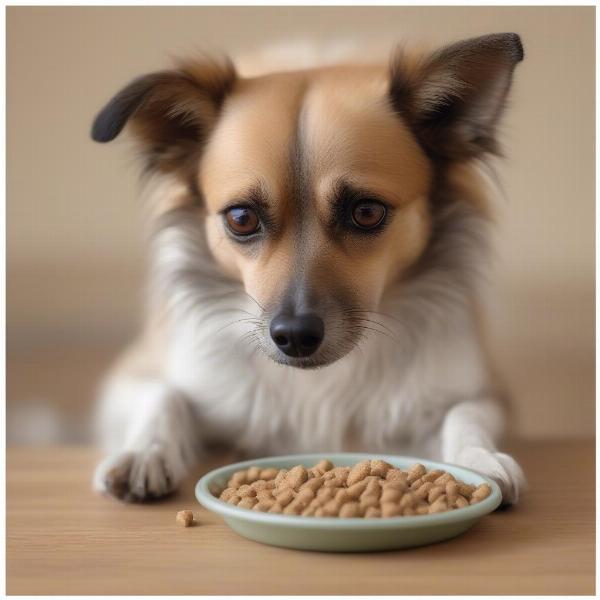Picking the right food for a fussy dog can feel like a never-ending battle. Whether your pup is a picky eater from puppyhood or has recently developed selective tastes, finding a palatable and nutritious diet is crucial for their health and happiness. This article will explore the best food options for fussy dogs, addressing common causes of picky eating and offering practical tips to encourage even the most stubborn eaters to clean their bowls.
Understanding Why Your Dog is a Fussy Eater
 Fussy dog cautiously eating from its bowl
Fussy dog cautiously eating from its bowl
Before diving into food choices, it’s helpful to understand why your dog is fussy. Several factors can contribute to picky eating, including:
- Medical Conditions: Underlying health issues, such as dental problems, allergies, or gastrointestinal upset, can make eating uncomfortable or painful. If your dog’s pickiness is a recent development, consult with your veterinarian to rule out any medical causes.
- Spoiling: Overfeeding treats, table scraps, or offering too many different food options can create a picky eater. Dogs quickly learn they can hold out for something tastier.
- Stress or Anxiety: Changes in environment, routine, or the presence of new pets can cause stress and affect a dog’s appetite.
- Previous Negative Experiences: A bad experience with a particular food, like getting sick after eating it, can create a long-lasting aversion.
- Breed Predisposition: Some breeds are known to be more selective eaters than others.
Choosing the Best Food for a Fussy Dog
The best food for a fussy dog will depend on their individual preferences and any specific dietary needs. Here are some key factors to consider:
- Palatability: Look for highly palatable foods with strong aromas and enticing flavors. Wet food is often more appealing to picky eaters than dry kibble due to its stronger scent and moist texture.
- High-Quality Ingredients: Choose foods made with high-quality protein sources, healthy fats, and digestible carbohydrates. Avoid artificial flavors, colors, and preservatives.
- Variety: Offering a small selection of different flavors and textures can help keep your dog interested in their food. Consider rotating between wet and dry food, or adding best kibble toppers for dogs to enhance palatability.
- Food Form: Experiment with different food forms, such as kibble, wet food, freeze-dried, or raw food, to find what your dog prefers.
- Nutritional Needs: Consider your dog’s age, breed, activity level, and any specific health requirements when choosing their food. Consult with your veterinarian for personalized recommendations.
Tips for Feeding a Fussy Dog
- Establish a Routine: Feed your dog at the same times each day and remove their bowl after 15-20 minutes, regardless of whether they’ve finished eating. This helps create a sense of predictability and prevents grazing.
- Avoid Free-Feeding: Leaving food out all day allows picky eaters to pick and choose, reinforcing their fussy behavior.
- Make Mealtimes Fun: Try using puzzle feeders or interactive toys to engage your dog with their food and make mealtimes more stimulating.
- Gradual Food Transitions: When introducing a new food, gradually mix it with your dog’s current food over several days to avoid digestive upset.
- Warm the Food: Gently warming wet food can enhance its aroma and make it more appealing to some dogs.
- Supplements: Sometimes, adding dog food supplements uk can increase a dog’s appetite and improve their overall health.
Conclusion
Finding the best food for a fussy dog requires patience and a bit of experimentation. By understanding the underlying causes of pickiness and trying different strategies, you can help your dog develop healthy eating habits and enjoy their meals. Remember to consult with your veterinarian if your dog’s pickiness is sudden or accompanied by other symptoms.
FAQ
-
My dog only eats treats, what should I do? Gradually reduce the number of treats you give and incorporate them into mealtimes as a topper for their regular food.
-
Is it okay to hand-feed a fussy dog? While occasional hand-feeding can be a bonding experience, avoid making it a regular habit, as it can reinforce picky eating.
-
Can I add human food to my dog’s kibble? While some human foods are safe for dogs, many are toxic. Consult with your veterinarian before adding anything new to your dog’s diet.
-
How long should I try a new food before giving up? Give your dog at least a few days to adjust to a new food, but if they consistently refuse it after a week, it might not be the right fit.
-
What are some signs of food allergies in dogs? Common signs include itchy skin, gastrointestinal upset, and ear infections.
-
Should I be concerned if my senior dog is suddenly eating less? Changes in appetite in older dogs can be a sign of underlying health issues, so it’s best to consult with your veterinarian.
-
My dog used to love companion dog food but now refuses it, what happened? Sometimes, dogs can develop preferences over time, or there could be a change in the food formulation itself. Try different flavors or brands.
ILM Dog is your dedicated resource for expert advice on dog care and nutrition. We offer a wealth of information on breeds, health, training, nutrition, grooming, and much more. If you have any questions or need personalized guidance, contact our team of experts via email at [email protected] or phone at +44 20-3965-8624. ILM Dog is committed to helping you provide the best possible care for your furry companion.